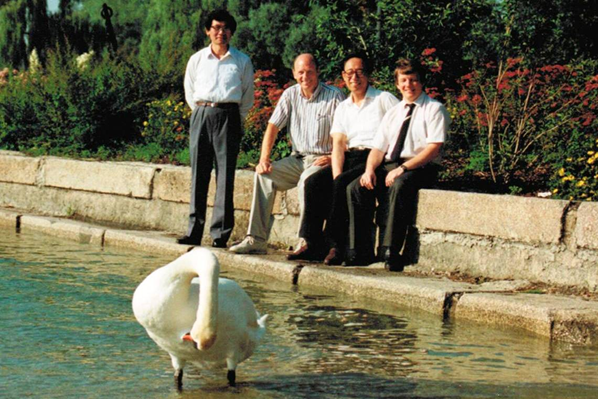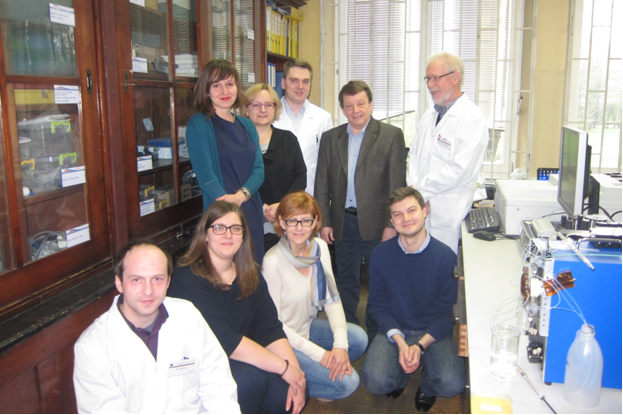5.11.2. Flow Analysis at the Faculty of Chemistry, Jagiellonian University, Krakow.
Pawel Koscielniak
Beginning of research in Flow Analysis at our Faculty dates back to 1986. At that time the work was focused on construction and optimization of devices designed to perform on line dilution of samples to be introduced to AAS spectrometer /1/. This work was further developed /2,3/ and led to a systematic study and formation of a research group of Analytical Flow Techniques (AFT). The nucleus for this development were research visits of Pawe? Ko?cielniak at Department of Applied Research, Perkin Elmer Co in Überlingen (1991-1992) and in Flow Injection Analysis Research Center in Shenyang in 1992. Participation in research work of Bernard Welz and Zhaolun Fang (Fig. 1.) provided valuable experience in Flow Injection Analysis (FIA), also leading to purchase of the first modular FIA systems from China.

Fig.1. Überlingen, 1990; from left to right sitting: Bernhard Welz, Zhaolun Fang, Pawel Koscielniak
Our research team (Fig. 2.) grew in size and our work continued in further development of automated calibration methods with aim to improve accuracy of analytical results. New concepts and a novel flow system were developed and tested on real life applications in environmental, pharmaceutical and food analysis.
In particular, a gradient based technique was invented, whereby an influence of interfering species was suppressed by a suitable buffering component present in the carrier stream /4/. Methodology of detecting and eliminating interferences was designed and combined with the standard addition method /5-7/. This work also led to development of new devices such as fully rotary valve, which was used for single- and two-component analysis /8,9/. A novel approach to calibration by extrapolative indirect method was also proposed [10].
In 2001 an "integrated calibration method" (ICM) was invented /11/ that appeared to be more efficient than conventional calibration methods and allowed identification, examination and elimination of the sources of systematic errors. The method was then developed methodologically /12,13/ and instrumentally /14-16/. More recently ICM was further refined as "generalized calibration strategy" by applying sample dilution on line /17,18/. This research segment culminated in a review and classification of flow-based calibration methods /19,20/.

Fig. 2. Team of Analytical Flow Techniques: from left to right sitting: Pawel Swit, Justyna Paluch, Jolanta Kochana, Pawel Knihnicki, standing: Anna Tobiasz, Joanna Kozak, Marcin Wieczorek, Pawel Koscielniak, Stanislaw Walas
In other research fields several flow titration approaches based on gradient /21,22/ or homogenous mixing /23/ were developed, investigated and discussed as indirect calibration methods /24/. Novel biochemical sensors were tested in flow based systems /25,26/. Using spectrophotometric detection, two-component assays have been developed based on careful selection of complexing reagents and single wavelength detection /27-30/. Preconcentration of target analytes is yet another topic of our research work. Using FAAS or ICP as detection systems various plant materials and water samples were analysed for trace constituents /31-35/.
The scientific results of the AFT team in the flow analysis area are ca. 70 scientific articles, 7 PhD theses, and more than 60 master's theses.
For a number of years our group has been also engaged in popularizing, education and training in flow based methodologies. In 1994 AFT group translated a monograph /36/, which is still the only Polish book on this subject. In Krakow we organized Symposia on Flow Injection Analysis in 1996, 1998, 2002, 2006, 2008, 2010 and 2014. In 2011 the 17th International Conference on Flow Injection Analysis in Krakow hosted 141 participants from 24 countries (Fig. 3.) including Jarda Ruzicka, Gary Christian, Elo Hansen, Purnendu Dasgupta, Marek Trojanowicz, Tadao Sakai, Jose Burgera, Victor Cerda and many other distinguished members of 'flow family'.

Fig. 3. Participants of "17th International Conference on Flow Injection Analysis", Krakow, 2011.









